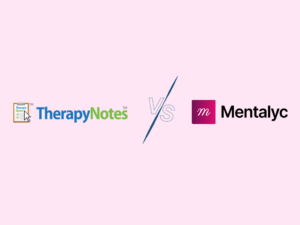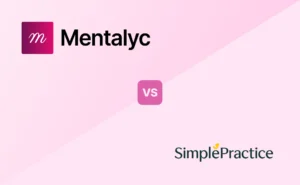Evaluating Risks & Addressing Suicidality in Therapy Notes: An Expert’s Guide for Mental Health Practitioners
Suicide, a tragic and heart-wrenching phenomenon, casts a dark shadow on families, friends, and communities, leaving behind a trail of total mayhem. The aftermath of such a tragedy underscores the pressing need for profound comprehension and proactive measures to thwart its occurrence. Interestingly, one recurring obstacle identified in the examination of suicide cases within inpatient mental health facilities is the dearth of information and documentation pertaining to suicide risk. Therefore, it becomes imperative to shift our focus toward comprehensive suicide risk assessment as the initial step toward fortifying suicide prevention. To that end, this article has been meticulously crafted, drawing from an array of peer-reviewed research, exemplary practices, and policy literature, all centered around the principles, techniques, and tools of suicide risk assessment in therapy notes.
Introduction: Understanding Suicidal Ideation
The contemplation of suicide, referred to as suicidal ideation, delves into the intricate realm of thoughts and plans centered around ending one’s life. These ruminations can range from fleeting considerations to meticulously constructed strategies. While some individuals may encounter suicidal thoughts as an isolated single occurrence in response to some events, others endure them regularly, sometimes even daily, for varying durations. Notably, such ideations are prevalent, often manifesting in response to heightened stress levels or traumatic experiences. Although most people who encounter suicidal thoughts do not follow through with self-harm, a fraction of them may attempt to take their own lives. This underscores the urgent need for every community to have unhindered access to the finest available care, provided within the least restrictive environment.
Documentation: What to Write When a Client Declares Suicidal Ideation?
As the client’s words reverberate, echoing their desire to end their life, counselors dive deep into what can be called -a critical situation- simultaneously delving into a quest for probing the root causes of the client’s distressing sentiments, all while orchestrating a collaborative roadmap, a blueprint for forging a path forward. Within this chaotic symphony of emotions, counselors must deftly navigate their own swirling inner turbulence that surge in this tumultuous high-stakes scenario.
Subsequently, the session comes to an end, and the client steps outside the counselor’s haven. Still, a lingering task awaits, evoking both dread and urgency—a task of utmost importance: documenting session notes.

New! Transfer your notes to EHR with a single click. No more copy-pasting.
While each client’s story is a unique tapestry, there exist some fundamental principles that can guide the art of crafting such notes. To craft an exquisite work of documentation, we shall delve into the exploration of four vital brushstrokes flourishing after a thorough suicide risk assessment: providing client data, identifying risk and protective factors, crafting a safety plan, and determining intervention while explaining your rationale. Let’s delve into each of them!
Conducting and Documenting A Risk Assessment
- Providing Client Data:
Within your note, vividly recount what propelled you to conduct a risk assessment. Was it an explicit declaration from the client, laden with poignant intentions of self-harm? Or did a subtle utterance escape their lips, bearing the weight of a profound yearning to vanish from existence? Delve into these crucial details, for they hold the essence of your reasoning, which we shall delve into deeper. Emphasize precisely what sparked the initial apprehension, and subsequently examine the client’s reactions as you embark on a quest for enlightenment. As a general guideline, any remark or action that impelled you to seek additional information must find its rightful place within your note.
- Identifying Warning Signs and Risk Factors:
Risk factors can be intertwined with an individual’s contemplation of suicide, extending their influence over an extended period. On the other hand, warning signs serve as indicators that can trigger the process of self-harm in the immediate future, encompassing mere minutes and days. These signs manifest in concrete ways, offering clinicians tangible evidence of an escalated risk of suicide in the short term, even in the absence of underlying risk factors. It is crucial to acknowledge that individuals who are not overtly expressing thoughts of suicide, seeking means, or making explicit threats may still carry a substantial risk.
Some people who genuinely desire to end their lives may conceal warning signs, making it paramount for clinicians to recognize and meticulously document all such indicators during the risk assessment procedure. Although the presence of potentiated risk factors may predispose an individual to a heightened risk of suicide, the actual establishment of this risk lies in the recognition of warning signs. For instance, being unemployed does not automatically categorize someone as being at risk of suicide. However, if an unemployed person begins to spiral into a deepening hopelessness, perhaps due to overwhelming debts or an inability to provide for their family, and expresses thoughts that suggest others would be better off without them, then their risk of suicide becomes significantly heightened.
The realm of suicide research presents us with an abundance of factors that contribute to suicide attempts. Not only should these factors be taken into account during the assessment process, but they should also be included in the accompanying notes. It is crucial to compile a comprehensive list of all identified factors from the current session, as well as those gleaned from previous sessions or the client’s history. For example, if the client has reported having a specific plan, recently experienced the loss of a spouse, and maintains a distant relationship with their children, these three indications collectively contribute to an extremely high-risk situation. In such cases, these factors would strongly support the recommendation for hospitalization if further details were provided.
Here are additional risk factors that tend to correlate with a heightened risk of suicide, which can be included in your notes, whenever applicable to your patient:
- History of previous suicide attempts (this remains the most strongly correlated risk factor for future attempts)
- Age of the client (adolescents and elderly males face the highest risk, as per recent studies)
- Gender of the client (males exhibit higher rates of completed suicides)
- Ethnicity of the client (particularly White and Native American individuals)
- Marital status (divorced, separated, or recently widowed individuals)
- Access to weapons or other means of self-harm
- Lack of social support
- Negative religious or cultural beliefs surrounding sexual orientation or identity
- Persistent feelings of hopelessness
- Recent significant stressors (such as being fired or laid off, expulsion from school, or the loss of a loved one)
- Family history of suicide or a close relationship with someone who died by suicide
- Perfectionism and low self-worth
- Substance use or substance abuse issues
- Identifying Protective Factors:
Likely, it is crucial to capture the essence of protective elements that may sway your judgment. Even individuals burdened by a desolate past and lacking in social support often attribute their pets as an unwavering deterrent to any contemplation of irreversible actions. It would be immensely beneficial to document this powerful safeguard in your records, particularly if you can capture the client’s poignant words, such as, “However, I would never entertain such thoughts because there is no one to care for Max.”
Consider incorporating these protective elements into your evaluation whenever applicable:
- Being married or having children
- Religious beliefs that discourage thoughts of self-harm
- Cultural values that disdain suicide
- A robust network of social support
- Adept coping skills, adept problem-solving abilities, and a track record of managing challenging behaviors
- Beloved animal companions
- A profound sense of optimism for the future
- An unwavering sense of personal control
- Access to adequate healthcare resources
It is essential to acknowledge that the purpose of documenting both risk and protective factors is to fortify your decision-making process, complemented by other evidence and an intricate rationale. Merely identifying these factors alone falls short of an all-encompassing personalized risk assessment and future planning.
- Safety Plan and Future Interventions:
A well-crafted safety plan emerges as a vibrant tapestry of tools and resources, interwoven with proactive measures for clients to navigate their inner landscape during moments of intense emotions or impulses.
Within the safety plan, one may discover an assortment of essential elements:
- Precise identification of triggers that may propel one towards the abyss of hopelessness or self-loathing.
- Well-established coping skills, honed through diligent practice and nurtured within the therapeutic sessions.
- Strategies to safeguard the surrounding environment, fostering an oasis of tranquility.
- A constellation of compassionate individuals, carefully chosen to provide unwavering support along with their contact information.
However, let it be known that the creation of a Safety Plan is a symphony composed in harmony with the client’s unique needs and aspirations. Like fingerprints, each Safety Plan bears the distinct marks of its creator, tailored to unravel the enigma of difficult days. It serves as a formidable shield, not only in times of expressed suicidal ideation but also as a vigilant guardian of prevention.
To supplement the information provided, we have included a link to a webinar that offers valuable insights into the topic. This video serves as an additional resource to enhance your understanding of suicide risk assessment in therapy. By combining written content with visual material, we hope to offer a comprehensive and informative experience for readers seeking knowledge on this critical subject.
Please note that the contents of the video are the intellectual property of its creator and are not owned or endorsed by Mentalyc.
A Word From Mentalyc: Tips & General Thoughts
As we ascend the ladder of risk assessment, a gentle sequence of questions emerges, gradually unraveling the mysteries of suicidal intent. All in all, a comprehensive risk assessment should at least tackle some of the following questions:
Do dark thoughts haunt the individual’s mind? Are they accompanied by the weight of despair? When did this shadowy presence first make its entrance? How steadfastly does it cling to their being? Can they, in their moments of anguish, wrest control over these intrusive whispers? And what formidable barriers have prevented these thoughts from manifesting into actions? Has the person woven intricate plans within the tapestry of their existence? Does their mind hold a precise map, outlining the method and place of their potential departure? Does the person possess the means to carry out their harrowing designs? For instance, do they have access to firearms that could seal their fate? Moreover, what is the lethality of their chosen method? etc.
As a final note, let us remember the importance of listening with empathy and employing a calm tone of voice during conversations. In moments of crisis, individuals may find themselves adrift, uncertain of their role. Thus, by modeling the desired behavior, speaking with a quiet and even tone, we offer guidance and aid in de-escalating their anguish. Furthermore, let us take the time to truly understand the person’s story, ensuring they never feel dismissed. As clinicians, we must see the individual in crisis as a person first and foremost, a being deserving of compassion and care. Let us empower them to recognize their inner strength, reaffirming that their choice to seek help was a commendable one. May we validate their feelings, helping them regain the reins of control over their own destiny.
References
- Stanley, B., & Brown, G. K. (2012). Safety planning intervention: A brief intervention to mitigate suicide risk. Cognitive and Behavioral Practice, 19(2), 256-264. doi:10.1016/j.cbpra.2011.01.001
- Bryan, C. J., Corso, K. A., Neal-Walden, T., & Rudd, M. D. (2009). Managing suicide risk in primary care. Primary Psychiatry, 16(9), 40-48.
- Jobes, D. A. (2016). Managing suicidal risk: A collaborative approach (2nd ed.). Guilford Press. http://www.sprc.org/sites/default/files/migrate/library/RiskProtectiveFactorsPrimer.pdf
- Mann, J. J., Apter, A., Bertolote, J., Beautrais, A., Currier, D., Haas, A., … & Hendin, H. (2005). Suicide prevention strategies: A systematic review. JAMA, 294(16), 2064-2074. doi:10.1001/jama.294.16.2064
- O’Connor, R. C., Pirkis, J., & Cox, G. R. (2020). The International Handbook of Suicide Prevention (2nd ed.). Wiley.
Why other mental health professionals love Mentalyc

“By the end of the day, usually by the end of the session, I have my documentation done. I have a thorough, comprehensive note … It’s just saving me hours every week.”
CDCII

“Having Mentalyc take away some of the work from me has allowed me to be more present when I’m in session with clients … it took a lot of pressure off.”
LPC

“It’s so quick and easy to do notes now … I used to stay late two hours to finish my notes. Now it’s a breeze.”
Licensed Professional Counselor

“A lot of my clients love the functionality where I can send them a summary of what we addressed during the session, and they find it very helpful and enlightening.”
Therapist






